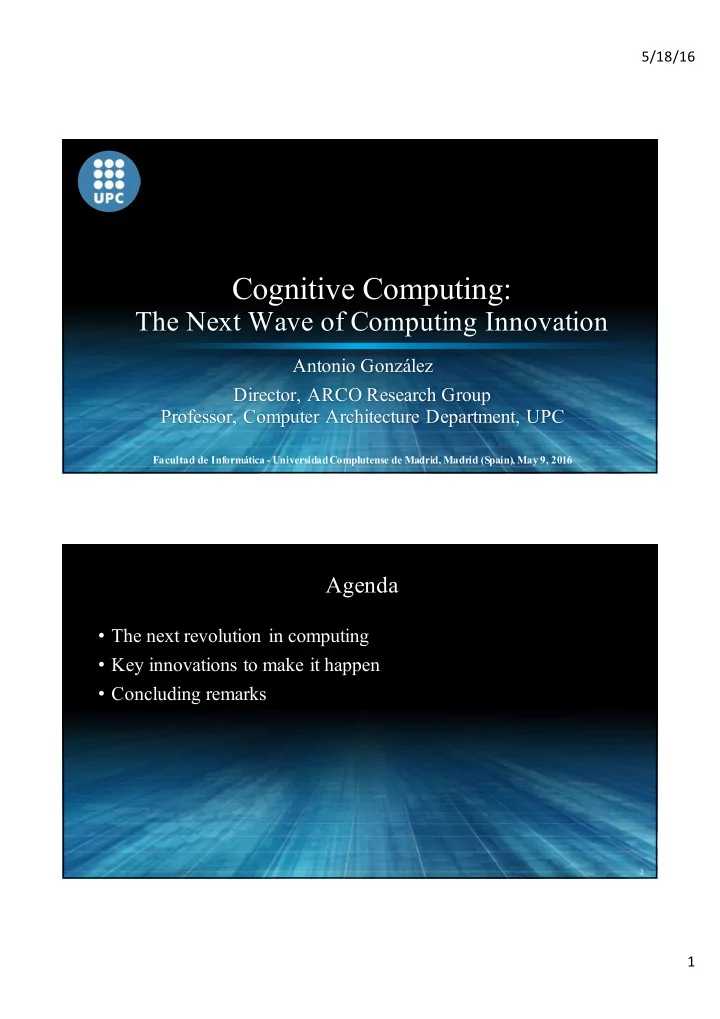

5/18/16 Cognitive Computing: The Next Wave of Computing Innovation Antonio González Director, ARCO Research Group Professor, Computer Architecture Department, UPC Facultad de Informática - Universidad Complutense de Madrid, Madrid (Spain), May 9, 2016 Agenda • The next revolution in computing • Key innovations to make it happen • Concluding remarks 2 1
5/18/16 A Revolution • From the Latin revolutio , "a turn around" is a fundamental change in power or organizational structures that takes place in a relatively short period of time Tools, 2.5 million BC Wheel, 4000 BC Fire, 1 million BC Abacus, 2700 BC 3 More Recent Technology Revolutions Transistor, 1947 Watt’s Steam Engine, 1859 Printing Press, 1450 Integrated Circuit, 1958 4 2
5/18/16 The First Revolution in Computing The First Computers ENIAC, 1947 Univac I, 1951 IBM 701, 1952 CDC 7600, 1969 5 The Second Revolution The Personal Computers PC Laptop Ultrabook Tablet Convertible Smartphone 6 3
5/18/16 The Next Revolution: Ubiquitous Intelligent Computing • Computing everywhere – On you – At home – At work – In the infrastructures • City • Roads • Public transportation • Interconnected – To cooperate and share data • Intelligent 7 Intelligent Computing • Intelligence - From "Mainstream Science on Intelligence" (1994) – Capability for comprehending our surroundings – Evaluate options and implications – Considering emotions and their effects – Proactively take decisions and autonomous actions – Learn from experience • Artificial general intelligence – Human-like intelligence of a machine that could successfully perform any intellectual task that a human being can (Wikipedia) 8 4
5/18/16 Intelligent Devices • Replacing, complementing and amplifying our senses – Vision – Language processing – Touch • Providing access to huge silos of information • Processing a large amount of information in real time • Providing real time responses – Personal assistants – Safety – Etc. 9 Very Diverse • Worn devices • Body sensors • Driving devices • Home robots • Healthcare devices • Energy management • Smart consumer electronics 10 5
5/18/16 Complex and Heterogeneous Systems Qualcomm Snapdragon 820 • Multiple computing elements • A few general purpose • Most specialized in particular computing domains – Graphics – Image processing – Audio processing – Encryption – Object recognition – Speech recognition Source: HotChips 2015 11 Key Enabling Technologies • Data analytics • Device and data security • Energy-efficient high performance 12 6
5/18/16 Data Analytics • Huge amounts of unstructured data (“big data”) • The challenge – Find the useful data (a tiny percentage of this huge volume) – Derive useful information from data 13 Security • Interoperability implies accessibility Source: Symantec • These devices will be used for very sensitive activities – Private data • Digital wallet • House key • Personal data – Control systems • Health care • Car driving • Access control (e.g. home) • Threats are increasing 14 7
5/18/16 High Performance • Typical tasks performed by these devices will have high computing requirements – Pattern recognition • Objects in real scenes • Spoken words • Facial identities and expressions • Anomalies (e.g. potential hazards when driving) – Natural language processing – Image and audio processing – Decision making – Etc. 15 Energy Efficiency • Small wireless devices with very limited battery capacity • Performance (“intelligence”) is limited by energy-efficiency – System power = EnergyPerTask * TaskPerSecond – To keep power constant • EPT has to decrease at the same pace as TPS (performance) Reducing EPT is the key for delivering increased performance 16 8
5/18/16 1.2 Reducing V dd Perf - 20% stall 1 Freq Power 0.8 • Great impact in EPT 0.6 – Linear effect on frequency à 0.4 almost linear effect on performance (less due to memory stalls) 0.2 0 – Exponential effect on leakage 0.5 0.6 0.7 0.8 0.9 1 – Cubic effect on dynamic power Relative Voltage • But it increases vulnerability Call for more resilient architectures 17 A Need for New Computing Models • Many simple units – Simple units have low performance but consume much less energy – More parallelism provides the desired performance at much lower energy cost • Much less data movement – For performance and energy reduction • More specialized hardware • New ISA and programming paradigms – Oriented to “intelligence”-related tasks (e.g. classification) rather than numerical algebra 18 9
5/18/16 Example: Brain-Inspired Computing • Human brain is very good at some of these intelligence-related tasks – E.g. object recognition • Human brain uses a very different computing model with many good properties – Composed of many simple units M. Sharad, C. Augustine, G. Panagopoulos, K. Roy, – Highly parallel “Spin-Based Neuron Model with Domain Wall Magnets as Synapse," IEEE Transactions on Nanotechnology, 20 – Fault tolerant – With a very different programming paradigm: learning 19 Example of an Architecture A feed-forward neural network A neuron 20 10
5/18/16 Deep Convolutional Networks • Deep Convolutional Network based on LeNet5 [1] – Multiple layers of different types – Suited for detection/recognition (e.g. image recognition) Feature extraction Classification (convolution NN & subsampling) (traditional NN) [1] LeCun et al., “Gradient-Based learning applied to document recognition”, Procs. of the IEEE, 1998. 21 Great Potential in Energy-Efficiency Pham et al., “NeuFlow: Dataflow Vision Processing SoC”, IEEE MWSCAS, 2012. 22 11
5/18/16 Summary • Next revolution in computing – A broad variety of intelligent devices – Ubiquitous – Applications very different to typical number crunching • Calls for new computing paradigms – Orders of magnitude improvements in energy efficiency • Massive parallelism • Error tolerant • Reduction in data movement • More heterogeneous and specialized hardware • New programming paradigms 23 “The question of whether computers can think is about as relevant as the question whether submarines can swim”, Edsger W. Dijkstra, 1984 Thank You! 24 12
Recommend
More recommend